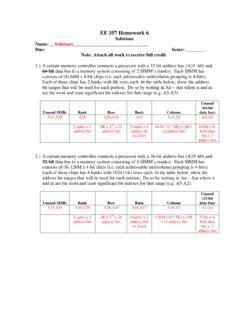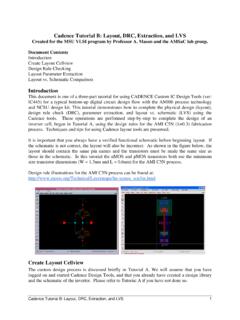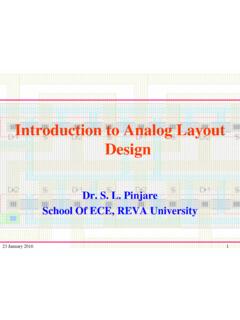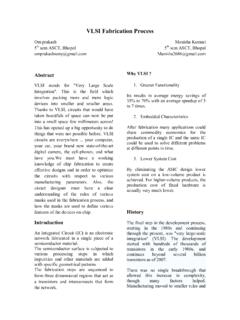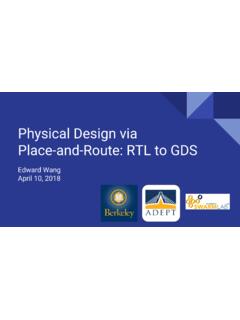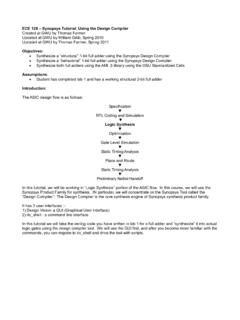Transcription of Cadence Virtuoso Tutorial - USC Viterbi
1 Cadence Virtuoso Tutorial version University of Southern California Last Update: Oct, 2015 EE209 Fall 2015 Table of Contents System Setup .. 3 1. Basic setup .. 3 2. Cadence setup .. 3 Basic Design Flow .. 5 1. Overall design flow .. 5 2. Create Library .. 6 3. Schematic .. 8 A. Create a cell view .. 8 B. Draw a schematic .. 9 4. Run Spectre simulation (Transient analysis) .. 16 A. Launch ADE (Analog Design Environment) L .. 16 B. Basic setup .. 17 C. Model Libraries .. 17 D. Stimuli .. 18 E. Choose a type of analysis - transient .. 20 F. Select signals to plot .. 21 G. Run simulation .. 21 H. Measurement .. 22 5. Run Spectre simulation (DC analysis) .. 25 A. Voltage Source .. 25 B. Replace Input Pin .. 26 C. Choosing Analyses .. 26 D. Run Simulation .. 27 6. 29 A. Create a layout .. 29 B. Add an instance - nmos .. 30 C. Add more instances pmos, ptap, ntap, and m1_ploy.
2 31 D. Draw metal1 .. 32 E. Run DRC .. 33 F. Add pins .. 35 G. Extract .. 37 H. Run LVS .. 38 I. Run Spectre simulation .. 39 System Setup Basic setup Cadence can only run on the unix machines at USC ( , Viterbi -scf1). You will need to remote login (XTerm) to these machines to run the tools. If you re using Windows, download X-Win32 2012 (for remote login) and Filezilla (for file transfer) from (usc account login required) If you re using MAC or Ubuntu, use terminal command ssh -X for remote login and scp or sftp for file transfer. If you re not familiar, please read this Tutorial for more information: If you have any license issues when you run X-Win32, you can either try to connect to USC Wireless Plus (how-to link: ) or use USC VPN (how-to link: ). a) X-Win32 Connection Setup To remote login using X-Win32, select Manual and choose ssh: Connection Name: (anything you like) Host: Login: (your account name) Command: /usr/bin/xterm Password: (your account password) Save your connection.
3 Launch it: If you see the xterm window like below, congratulations your X-Win32 is all setup. b) Filezilla Connection Setup Open Filezilla, use as host and 22 as Port. The username and password are the same as your X-Win32 connection. Navigate and choose files from the left window to upload and files from the right window to download. Cadence setup Before you start, familiarize yourself with the following linux commands: ls // List files pwd // Show your current directory cd // Navigate to some directory mv // Move cp // Copy rm // Remove mkdir // Create a directory Google them for more information about their usage if needed. You can find 'cshrc_linux' , and ' ' from site. Note that the file entitled 'cshrc_linux' should be renamed to '.cshrc' after uploading it in your home directory. Download .cshrc, and from under Lab Tutorial .
4 Use Filezilla (or scp) to upload these files to your home folder on Viterbi -scf1. Make sure they are named .cshrc or exactly. Type command ls a to list all files under your home directory: ls -a If you need to edit the linux files, don't edit them by Window based editor ( , Word, Text). You have to use unix editors, such as gedit, vi, If you need to rename those files to .cshrc or , use command mv , for example, to rename cshrc to .cshrc, you can say: mv cshrc .cshrc Convert the encoding of those two files by dos2unix command: dos2unix .cshrc dos2unix Create a folder named cds: mkdir cds Copy useful files to your cds directory: cp ~ee577/design_pdk/tsmc25/files/* ./cds/ cp ~ee577/design_pdk/tsmc25/files/.cds* ./cds/ Check you have the following files in the cds folder: ls -a ./cds/ .cdsinit // Cadence initialized file .cdsplotinit // Cadence printing setup file // Cadence library setup file // Binding key files for shortcut keys // TSMC 25 spice parameters // Binding key files for shortcut keys Now go to the cds folder: cd cds Use gedit to open : gedit This step is no more necessary Add the following line to it; do not remove any existing content: INCLUDE $CDK_DIR/ Go back to your home directory: cd.
5 Or you can you type 'cd ~', whenever going back to home directory Copy the Cadence environment files to your cds working directory: cp ~ee577/design_ ./cds/.cdsinit Copy the .simrc file to your cds directory: cp ~ee577/design_ ./cds/.simrc Then you can source .cshrc file: source .cshrc If nothing comes out, then you re successful: Please remember that you need to source .cshrc every time you login before running Virtuoso . You don t need to repeat other steps though. To run Virtuoso , now go to cds directory: (always run Virtuoso in the cds directory) cd cds And open Virtuoso : (by adding & you can use Virtuoso and xterm and the same time) Virtuoso & Make sure you can see those NCSU_XX libraries and then you re all set! .cdsplotinit // Cadence printing setup file // Cadence library setup file // Binding key files for shortcut keys // TSMC 25 spice parameters // Binding key files for shortcut keys A.
6 Make sure you can run Cadence tool by typing. %which Virtuoso /usr/usc/ Cadence /2009/IC610/tools/dfII/b in/ Virtuoso B. Go to your home directory, open your .cshrc file and add the following lines at the end of this file: setenv CDK_DIR /home/scf-06/ee577/design_ setenv CDS_Netlisting_Mode Analog C. Close the .cshrc file and source this file by typing the following command: % source .cshrc D. Open the library file which is located in your cds directory. Just add the following line to Do not remove existing contents in : INCLUDE $CDK_DIR/ E. Go to your home directory. Copy the Cadence environment files to your cds working directory by typing the following command while you are in your home directory: %cp ~ee577/design_ ./cds/.cdsinit F. Stay at your home directory. Copy the .simrc file in your cds directory by typing the following command while you are in your home directory: % cp ~ee577/design_.
7 /cds/.simrc Note that the name of the file that you are accessing is cdsinit but you need to save it as .cdsinit . Also note that you may already have a .cdsinit file from the past in your cds directory. In this case you still need to overwrite it by this new file. G. Always invoke " Virtuoso " in your ~/cds directory because all setup files are in this directory. Type Virtuoso & at the command prompt. The & is for background execution, it is useful when we want to keep the command prompt in the same console. Basic Design Flow 1. Overall design flow Following flow chart shows overall design flow. 2. Create Library For prompt to access for higher tiered license, click always . A. Tools Library Manager B. File New Library C. Give a name and attach it to a technology library 3. Schematic A. Create a cell view select the library just created, File->new B.
8 Draw a schematic i. Add instances pmos You can modify Width of transistors. Don t modify length unless you have a special purpose. You should select a NCSU_Analog_Parts library. ii. Add instances nmos, vdd, and gnd iii. Add wires: Create Wire iv. Add pins: Create Pin We have for different types of direction. For schematics, we only use two types, input and output. InputOutput type is for supply changes, and it is necessary only for layout. We will discuss about this later. Check and save to make sure there are no errors. Now, we completed a schematic design. C. Create a symbol (Optional) For hierarchical design, we may need to make symbols of designed circuits. Create CellView From Cellview Remember that when you use more than one symbol in schematic, they all will have common Vdd and Gnd even if there are one Gnd and Vdd for each symbol (in the original design).
9 To design with symbols in layout, you should make sure that all of the Vdd and Gnds are connected. 4. Run Spectre simulation (Transient analysis) We will run spectre simulation. This section is for both schematics and layouts. I will show an example for a schematic. You can do the same thing for a layout. A. Launch ADE (Analog Design Environment) L Launch ADE L B. Basic setup Check if your simulator is spectre. You can modify project directory. C. Model Libraries You can download a library file at the DEN blackboard. Put the tech file under /home/scf-10/your-user-name/cds/techfile s/ Please only use the provided tsmc file because some tsmc files does not work correctly. D. Stimuli Define input signals include supply nets (for layout, vdd! and gnd! are under inputs and both should be enabled.) Global sources Input (change) Remember to check Enabled button and then press OK or APPLY otherwise you will lose the configured numbers.
10 E. Choose a type of analysis - transient You can choose dc if you want to do dc analysis A. Choose tran B. Give Stop time which means how long you want to simulate C. Select moderate as accuracy defaults D. Do not check Transient Noise E. Check Enabled F. Select signals to plot Outputs To Be Plotted Select On Schematic Click a signal (Pin) on a schematic/extracted. In Extracted try to use pins for signal that you need in the simulation because it is hard to select a net in the extracted view. G. Run simulation Simulation Run If you see a waveform like above picture, you followed every step properly. Good job!. H. Measurement The following steps describe the measurement of rise time. Using similar steps other parameters of delay, fall time can be estimated. Invoke the calculator or tools-> calculator , select the Wave radio button: In the functions window choose all Select the rise time option Select the signal from the waveform window whose rise time needs to be determined and click OK : Click the evaluate buffer to display results as follows You can also select a signal from calculator for example cos(Vin) as one of the plotted signals and you can see the results whenever you run the simulation.
